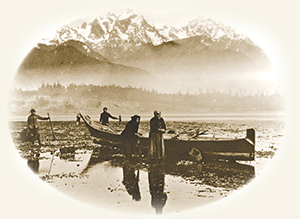To See a World in an Oyster’s Shell
WSG Social Scientist Melissa Poe shows how shellfish are central to tribal harvesters’ sense of being and belonging.
By Lauren Drakopulos, WSG Science Communications Fellow
By Lauren Drakopulos, WSG Science Communications Fellow

That’s what Melissa Poe, Washington Sea Grant’s Social Scientist, and Jamie Donatuto, an Environmental Health Analyst with the Swinomish Indian tribal community, set out to discover. The goals of their project, funded by the University of Washington’s Puget Sound Institute, were to evaluate sense of place as a cultural ecosystem service of Puget Sound and examine the links between shellfish harvesting, healthy marine ecosystems and human well-being.
To meet these goals, Poe and Donatuto interviewed and conducted a series of workshops with Squaxin Island and Swinomish tribal members and other residents of South Puget Sound and the Skagit River area. They looked at shoreline harvesting because, as Poe puts it, “It is a type of tangible activity that broadens how we think of cultural ecosystem services.” Environmental professionals have tended to view these cultural services as nonmaterial benefits, such as recreational, spiritual and therapeutic experiences of natural environments. They usually see harvests as a provisioning activity, performed to obtain a consumable product and resulting in a net loss for the environment. But for the communities who harvest, says Poe, “The practice of shellfish harvest is not just provisioning. It has connections to other kinds of immaterial well-being.”
Working in close collaboration with the tribal communities, Poe and Donatuto found that shellfish harvesting and other shoreline activities “create deep, strong and intergenerational connections to place…. People’s sense of place is really integral to who they are as individuals.” As one harvester told them, “Since I was two, I’ve lived on the water…. That’s where I spent my formative years, and I think it’s part of who you are when you have been raised with it.”
When sense of place is considered in environmental management decisions, it’s usually understood as merely an appreciation of wilderness or a scenic vista. Poe’s work shows that such purely aesthetic definitions can be limiting because they neglect environmental quality. “By seeing Puget Sound primarily as a beautiful glistening body of water,” she notes, “we risk not paying attention to the health of what’s under the surface.”
Policies that equate sense of place with scenery and seek to maximize aesthetic qualities may actually suppress rather than nurture a sense of place. Conservation approaches that define harvest activities as merely “extractive” may prevent some residents from developing a sense of place that is culturally specific and historically meaningful. As one harvester told the researchers, “I associate myself with oysters; they’re a part of my identity.”
This raises an important social justice issue. Because of such cultural connections, the impact of restrictive management falls more heavily on some residents than on others. Traditionally managers have accounted for this impact through substitution, a measure that assumes that as some resources become less available people can shift to other resources. But for the study’s tribal participants, some shoreline resources and places were irreplaceable. “It would be that devastating,” one harvester attested, “and maybe it would be even worse; if they told me I could never be by the water, it would be like the end of the world to me…. It would be probably the deepest grief I could never get over.”
Further reading: Poe M, Donatuto J, Satterfield T (2016) “Sense of place”: human well being considerations for ecological restoration in Puget Sound. Coastal Management Journal 44(5).